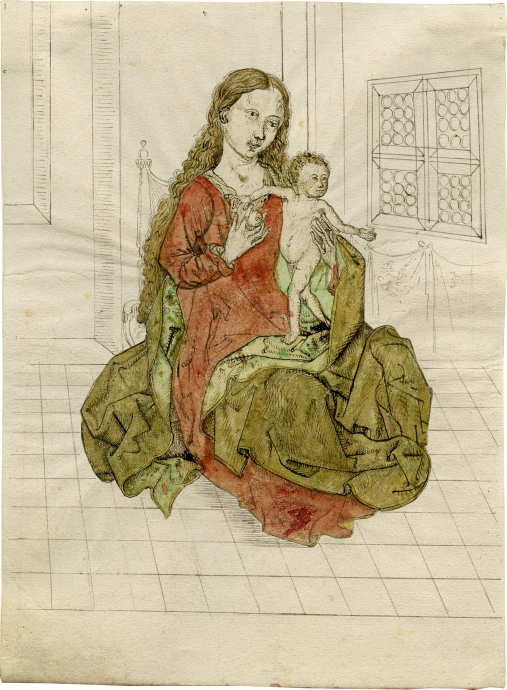Drawing of the Madonna and Child



Upper Rhenish School
, Upper Rhine, c. 1490Upper Rhenish School
Description
Two drawings on paper, one of the Madonna and Child pasted over a later drawing of an interior, the former pen and brownish-black ink, highlighted with watercolor wash in ochre, green, and red, watermark on the latter, slight stains, various notations in different 20th century hands on the verso.
Provenance
Perhaps Odenwald, Amorbach Cloister (later hand-written inscription on verso); Private Collection HB [Berlin], collector's mark in red on verso of board (Lugt 3499?); Essen, Professor Dr. Peter Kroeker, 1950s; Gallerie Arnoldi-Livie, Munich.
Cut out from a larger composition, this highly finished drawing of the Virgin and Child - skillfully drawn freehand (not traced) with pen and highlighted with dense watercolor wash - was probably executed as an independent work in its own right.
The drawing unites two iconographic traditions. The first, the standing Christ Child in the lap of the seated Madonna dressed in ordinary clothes, relies on an Upper Rhenish model of the Virgin of Humility from the third quarter of the fifteenth century (Lehrs 69). The standing Christ Child in a similar twisting pose occurs also in the Large Einsiedeln Madonna by the Master E.S. of 1466 (Lehrs 81 and 82). The second, the Nursing Virgin (or Madonna Lactans), depicts the Virgin interrupted in the act of nursing as she squirts milk at Saint Bernard of Clairvaux, who kneels praying by her side (an event that allegedly took place at Speyer Cathedral in 1146 and that gained popularity as a symbol of the wisdom imparted by the Virgin's milk to the Saint). On our drawing, both the gesture of the Christ Child who stretches out his left hand and the Madonna's grasp of her breast to squeeze the milk suggest that the image of Saint Bernard once occupied the right side of the composition and was later removed (compare Israhel van Meckenem, Lehrs 210-212).
Where the drawing was made deserves further study. Detailed notes in pencil on the reverse record Friedrich Winkler's expertise with the date c. 1485 and the observation that the drawing originated in the Amorbach Cloister in Odenwald based on the origin of another drawing in a South German private collection. We have been unable to verify these remarks. In spite of the contemporary watermark, it seems reasonable that the drawing of the interior of the room, onto which the cut-out drawing is pasted (showing a double window, the throne on which the Virgin sits, and a succession of rooms in the rear left), was executed later, as Dr. Koreny suggests.
We are grateful to Dr. Fritz Koreny for his expertise.